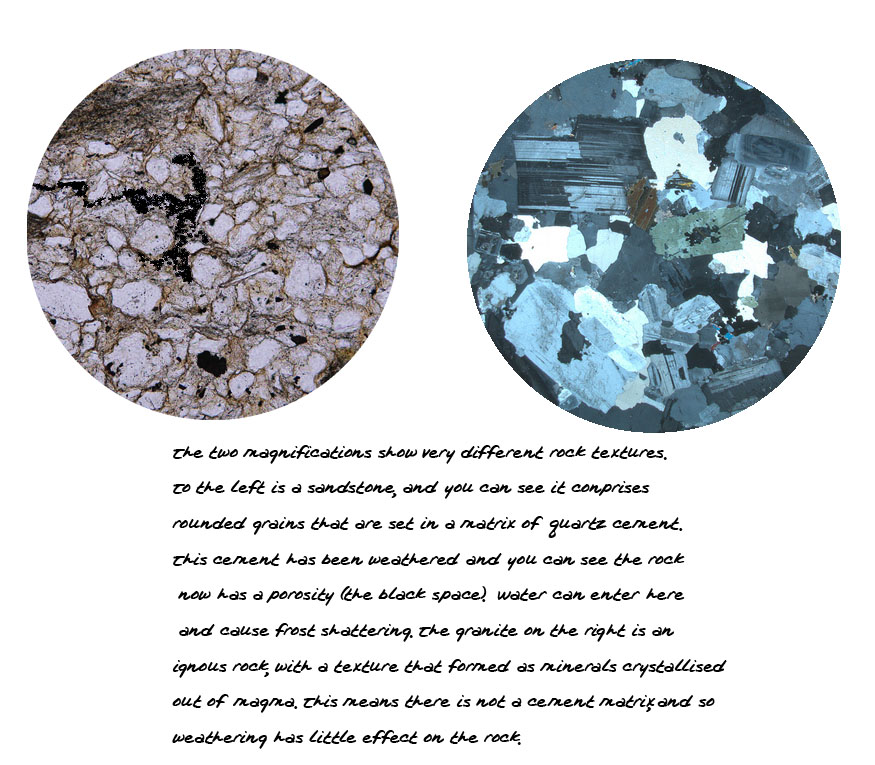Learn how the landscaped was shaped in Lepton:
Lepton is one of the oldest settlements here in Kirklees, and allows us to study the various buildings to compare how different building stone has responded to the weathering process. Starting near the church, a good place to understand how weathering affects a stone is in the graveyard.
Weathering is the process by which rocks decompose in situ - not to be confused with erosion, in which rocks are broken down through movement by water, wind, ice, or even just gravity.
The graves are well exposed to the elements here and are made up of various different materials that can then be compared. Most importantly is the fact that graves display a date, so we know roughly how long the stone has been subject to weathering processes.
Three modes of weathering exist;
1. Physical Weathering
2. Chemical Weathering
3. Biological weathering
Physical weatheringoccurs through an agent, namely water, that can enter pore spaces (the gaps between individual grains, and freeze to expand. This often induces frost shattering. Water is also an important agent inchemical weathering, again entering pore spaces and reacting with the minerals in hydrolysis to decompose the rock.
Biological weatheringoccurs when mosses and lichens grow on rocks and decompose the minerals as a source of energy. This often incurs a weakness in the rock which larger plats can then exploit through root action. We see this later in the walk.

If you examine the graves you can detect the effects of each mode of weathering. Try to find rocks that have been physically broken up, and then a surface that appears to have disintegrated through chemical processes.
Compare the sandstone, limestone (grey/blue), and granite (dark sparkly rock) graves to determine whichlithologyis more resistant to weathering. To make this scientific, consider the two variables; the age of the gravestone, and the type of gravestone. You can see that older stones are always more weathered. But compare a granite grave with a sandstone grave from the same age. Granite seems to be the most suitable material if you want longevity, as it is most resistant to weathering. This is because it is an igneous rock, with littleporosity.
You can also see variation in weathering between different sandstones, depending on grain size, mineralogy, bedding planes and cementation of the grains. These properties are of great interest to geologists who look to understand a rocks origin, and potential use.
Before you turn on to Lydgate, the oldest part of Lepton, compare the new build to the old. Although the materials and style of the buildings matches those 200 year old buildings, you can determine their age from the weathering.
Walking past the farm onto Dam Head Lane, you might notice a strange hill to your right. This is a spoil heap from Dam Head Colliary.
The history of coal mining in Lepton in one of the oldest in West Yorkshire, with a coroner's report from 1357 describing the death of John Long down a pit (this being the first account of the coal extraction industry in Kirklees).
Coal mining has occurred in Lepton up until very recently, and in the 1920s, the area was known for its 'day pits' which were informal open cast operations that were developed on farm land during the general strike.
The industry that dominated Lepton until recently was the Spa Green Brick works and the accompanying clay pit, on which is now built the housing estate, Thorgrow Close, that you walk past as you cross Station Road. This industry exploited the presence ofalluvium claywhich had been deposited by glacial meltwater rivers 17000 years ago. The use of bricks as a building material revolutionised house buildings, as they could be manufactured on mass without the need for stone masons, and are much more resilient to weathering than stone, lacking bedding planes and soluble matrix of sandstone.
As you walk through Jumble Wood, you will come across a stream that has steep clay banks and several layers of sandstone. This is an interesting locality because you can see the action of tree and plant roots on the weathering process. Much of the strata towards the top of the river cutting has been heavily disturbed by the growth of roots. This mechanical action on the rock is vital in producing permeability in the rock for water to then exploit.
Another relic of the once prosperous coal mining industry can be seen as you cross this field back up to the church. You can see the route of a tramway to your left. If you look at old maps of the area, you can see that most pits would have a tramway system to transport coal to road and rail links.